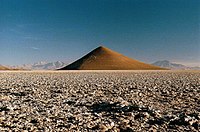
Photo from wikipedia
Abstract Continual advances in quantitative modelling of surface processes, combined with new spatio-temporal and geo-computational algorithms, have revolutionised the auto-classification and mapping of landform components through the automated analysis of… Click to show full abstract
Abstract Continual advances in quantitative modelling of surface processes, combined with new spatio-temporal and geo-computational algorithms, have revolutionised the auto-classification and mapping of landform components through the automated analysis of high-quality digital elevation models (DEMs). Digital geomorphic mapping (DGM) approaches that can simplify and translate the inclusion of “human knowledge” to automatic terrain classification across a broader spectrum of terrain morphological units as well as a range of spatial scales, therefore, offer great potential for improved topographic and landscape analysis. One such approach is the mapping of landform elements using the concept of the Geomorphon (geomorphological phonotypes). The output of the geomorphon approach is the stratification of the landscape into ten unique but recognisable landform elements: peak, ridge, shoulder, spur, and slope, hollow, foot slope, valley, depression and flat. Equally appealing is the way the model self-adapts to local topography using a line-of-sight principle enabling better matching of landform elements to computational spatial scale. The purpose of this paper is to observe the effects that different pixel resolution (grain size) and digital elevation model source (DEM) would have on the replication of observed geomorphic spatial patterns and representation of terrain selected parameters within the landscape. This paper provides a comprehensive exploratory assessment of digital terrain representation and relief classification using an automated geomorphometric mapping approach, by evaluating three different digital surface models (SUDEM, SRTM, ASTER GDEM2) and different spatial resolution (30 m & 90 m) for an 11,200 ha catchment in KwaZulu-Natal, South Africa. To test the self-adapting ability of the geomorphon approach under regional conditions, we use 4750 gridded terrain samples to quantitatively analyse how the choice of terrain model and scale influence the extraction, generalisation and representation of digitally-derived terrain attributes such as slope, elevation and terrain unit feature extent. We further show how the variation in resulting terrain unit representation is limited by spatial resolution discontinuities of selected elementary soil association distribution, soil texture and soil depth. We also introduce the results of a Similarity Index used to gauge the degree of recall and precision between the different geomorphic landscape features. Finally, the findings of the regional geomorphon-soil relationships are presented in a readily interpretable and qualitative manner, providing a “quasi-landscape signature” for potential localised geomorphons. The application of the study findings may be beneficial to practitioners looking to align or refine modelled terrain classification approaches with expert perception and formalised heuristic approaches.
Journal Title: Geoderma Regional
Year Published: 2020
Link to full text (if available)
Share on Social Media: Sign Up to like & get
recommendations!